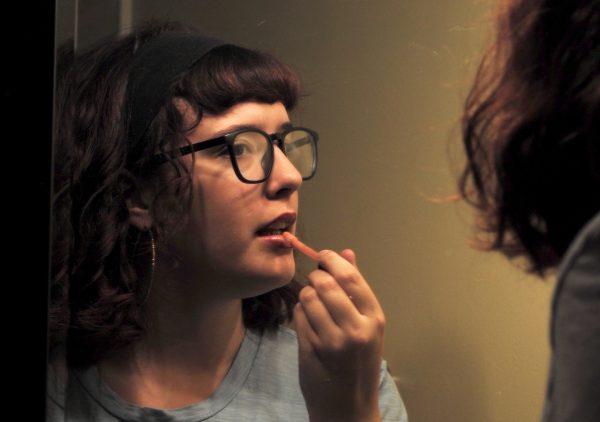“It happened to me.”
photo by Chanson
The recent media coverage over the statistic “97%” has once again brought light to just how big of an issue sexual harassment is, and how many women are afflicted even in our school.
Your last boyfriend was manipulative, gaslighting or manipulating you psychologically into believing you were not enough. The $20 he spent on your lunch was not a kind gesture, but an unspoken agreement that you were now in his debt. That simple kiss was more than simple; it was your consent that he could go further, even if that was not your intent. Those you told said you must have wanted it if you didn’t push him off, even though he is half a foot taller and 100 pounds heavier than you.
Jane* was sexually assaulted her junior year. Since then, she cannot handle intimate moments without getting uncomfortable or being wary of men.
“I don’t think sexual assault and harassment are taken seriously unless it’s considered rape. I think often it’s overlooked and even blamed on the person who was affected,” Jane* said. “A lot of times people ask, well why didn’t you say no? Why didn’t you walk away? Why didn’t you tell them to leave you alone?”
Sexual assault is what most people are used to hearing about when describing sexual violence. It is defined by RAINN as “sexual contact or behavior that occurs without explicit consent of the victim.” Including: “attempted rape, fondling or unwanted sexual touching, forcing a victim to perform sexual acts, such as oral sex or penetrating the perpetrator’s body, and penetration of the victim’s body, also known as rape.”
Sexual harassment is more common than sexual assault but still just as harmful. It is defined by the Equal Employment Opportunity Commission as “unwelcome sexual advances, requests for sexual favors, and other verbal or physical conduct of a sexual nature.” Sexual harassment is a broad term that encompasses gender harassment, quid pro quo sexual harassment, and hostile environment harassment. Yet gender harassment is the most common form of sexual harassment aimed primarily at women, and according to RAINN, only 19.5% of sexual violence is committed by a stranger.
“I had made it very clear that it not only made me uncomfortable but I wasn’t willing to do that [have sex] just yet. It didn’t matter. He ended up just touching me all over and I couldn’t get him to stop,” Jackie* said. “The only reason I wasn’t raped that night is because his mom walked in. Nobody knows what happened, but even now I can’t stand to be touched by anyone.”
Many women have a story similar to this one but are either too afraid to talk about it or do not know how. The UN released a survey in March 2021, gathering research on 1,000 women between the ages of 18 and 24 on their experience with sexual assault. The result was that 97% had experienced any of the behaviors exhibited by sexual harassment including groping, catcalling, receiving unsolicited nudes, ogling, etc. Recently social media has taken to the 97% statistic, sharing awareness online.
“Reading that statistic made me so sick to my stomach. It’s so saddening that so many people have been affected. It also makes me sad that many of the women around me didn’t even realize that they were part of that 97% because many of the components of sexual harassment have been normalized in our society,” Jackie said.
The survey only included women living in the UK, but it has gained global traction spreading quickly through Instagram posts and people coming forward about their own stories. This one survey was enough to encourage women they were not alone in their experiences and bring attention to how big of an issue it truly is, happening even to young girls.
“I was in eighth grade. My boyfriend at the time wanted to start doing more sexual things with me, so he did,” junior Anna Hawkins said. “I told him about my doubts surrounding it but he pressured me until I caved.”
A PEW Research Center survey in 2018 was based on the experiences of American women, which represented around 6,251 adults. More than half surveyed said they had faced some form of sexual harassment such as unwanted sexual advances and both verbal and physical harassment of a sexual nature.
It may seem like this study produced a drastically lower statistic but realistically the number is still dangerously high. Even if you have not experienced sexual harassment yourself, someone you know has.
“In many ways, society is way more aware of the extent of this issue, yet at the same time won’t do anything about it,” senior Natasha Nilsen said. “It does nothing to say ‘don’t rape’ if young men aren’t thoroughly taught to behave.”
Victim blaming is one of the reasons many women are afraid to come forward about their experiences. When women come forward they are held entirely at fault for the harm done against them. Questions like “what were you wearing?” discourage people from speaking up.
“Many women who have reported it don’t win their case because no one believes them. They just let the attacker go. Or people try to convince the victim it is their fault. It’s terrifying to come forward,” Lisa* said.
Specific to gender-based sexual assault, what happens to victims has become normalized. Men are glorified for “getting some”’ and encouraged to view women as objects reflective of the media’s portrayal of male-female relations. Victim blaming hinders the willingness of victims to come forward, but so does the idea that they will simply be dismissed after sharing.
“I’ve known so many so many of my friends who refuse to speak out about their experiences due to the fact that they think people won’t believe them,” Hawkins said.
The 97% trend is not the first to bring light to this issue. The phrase “no means no”, which became popular in 2018, has brought awareness to the organization No Means No Worldwide, which is working towards ending sexual violence against women and children.
However, the most recognizable movement was the Me Too movement, which was founded in 2006 by a survivor and activist Tarana Burke and blew up in 2017 with the popular hashtag #metoo. Women all around the world shared their stories, letting those that have experienced similar situations know they are not alone. These movements are important because many girls struggle to understand their own situation.
“We need more sexual assault and harassment education, so girls know when to identify certain situations and guys know when to stop. More in a sex-ed type class and unit should be on sexual harassment and assault prevention so we can implement it in kids and make them more aware of what it is and how to avoid it,” Beth* said.
It is easy to separate what is shown in social media from everyday life, and many people do not understand how common and how big of an issue sexual harassment is even in our schools. The statistics only survey women above the age of 18 but many of their experiences started before then.
“The main thing was freshman year on campus. I was working on a hoco float and this guy complimented my thighs. I was confused but laughed it off,” Julie* said. “When I turned my back he grabbed my upper thigh, almost my butt, and gripped it. He acted nervous but played it off. I confronted him the next day in front of his friends and they all just yelled at me and called me crazy. I was so embarrassed and uncomfortable.”
Sexual harassment only becomes a topic of discussion when it is trending and it is still a present issue in the lives of many women. It is true that it can happen to anyone.
Women can be sexual harassers and men can harm other men, but that does not mean women should feel uncomfortable coming forward with their experiences.
“We always teach girls that it is our fault, that we shouldn’t have acted that way, or should have not worn that dress,” Nilsen said. “Yet in reality, they should be teaching men to keep their hands to themselves, to be respectful, and to understand that no is no.”
*Names have been changed upon request.
Your donation will support the student journalists of Hagerty High School. We are an ad-free publication, and your contribution helps us publish six issues of the BluePrint and cover our annual website hosting costs. Thank you so much!













